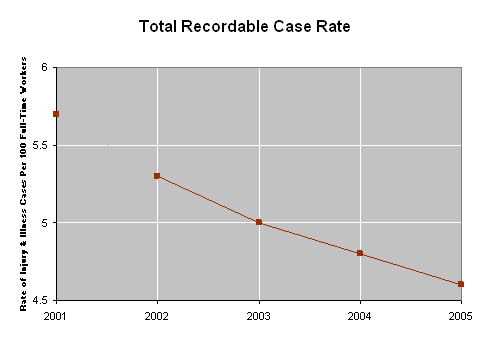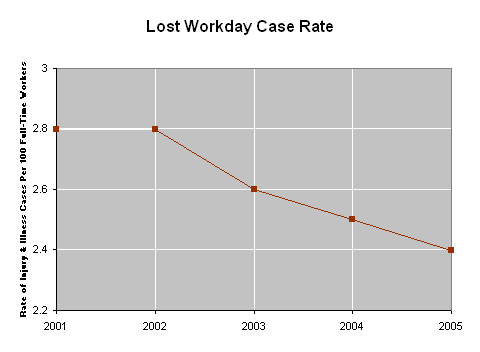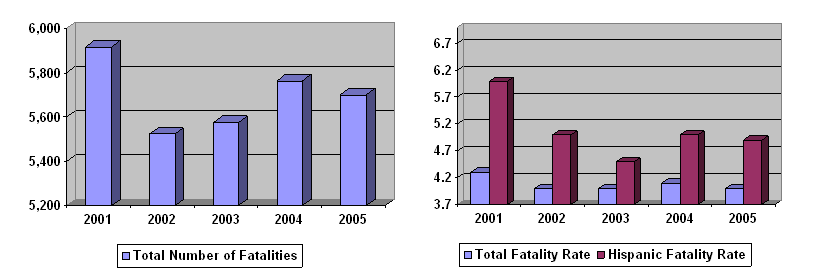
| U.S. Department of Labor |  |
|||||
| Occupational Safety & Health Administration | ||||||
| «« Back to the Enforcement Activity Page
OSHA's purpose is to promote and to ensure workplace safety and health and to reduce workplace fatalities, injuries and illnesses. Although OSHA must respond to new challenges from emerging industries, new technologies, and an ever-changing workforce, OSHA's mission remains the same. OSHA enforcement, using mechanisms such as Site Specific Targeting (SST), Local Emphasis Programs (LEPs), National Emphasis Programs (NEPs), and the Enhanced Enforcement Program (EEP), plays a vital role in fulfilling that purpose. OSHA enforcement remains focused, active, and effective. There are many components to OSHA's effort, and multiple intermediate measures of its effectiveness. Ultimately, the most important measure of OSHA'effectiveness is the number of employees who go home everyday healthy and uninjured. OSHA's Enhanced Enforcement Program Shows Continued Success in FY2006 The Agency's Enhanced Enforcement Program (EEP) focuses on employers who, despite OSHA's enforcement and outreach efforts, repeatedly ignore their OSH Act obligations, and place their employees at risk. EEP targets cases with extremely serious violations related to a fatality or multiple willful or repeated violations. During the first three years (FY2004-2006) of the program, OSHA identified an average of 459 inspections per year that qualified as EEP cases. OSHA identified 467 EEP cases in FY2006. The objective of EEP is to assure sustained compliance at these workplaces. If an inspection is classified as an EEP, then it may receive, among other things, follow-up inspections, inspections of other workplaces of that employer, and more stringent settlement provisions. OSHA Enforcement Activity in the Seven Target Industries Remains Robust In 2003, OSHA developed a 5-year Strategic Management Plan (SMP) directing the Agency's resources towards three overarching goals, one of which focuses on the reduction of occupational injuries, illnesses, and loss of life. To accomplish the goals of fatality, injury, and illness reduction set forth in its Strategic Management Plan, OSHA identified seven industries with high injury/illness rates and a high proportion of severe injuries/illnesses for focused targeting of outreach, education and enforcement activity. These industries include:
Local Emphasis Programs Play a Major Role in OSHA Enforcement Local Emphasis Programs (LEPs) are enforcement strategies designed and implemented at the Regional Office and/or Area Office levels. Nationwide, there are over 150 individual programs (sometimes implemented by multiple offices) that address a wide range of industries and hazards such as:
Injury and Illness Rates Fall to All-Time Lows Total recordable and lost workday case rates continued their steady decline. The rates for calendar year 2005, reported on October 19, 2006, were the lowest that BLS has ever reported. The rate at which employees experienced a recordable injury has decreased by 13.2 percent since 2002 and the lost workday case rate declined by 14.3 percent over the same period. The continued decline in the lost workday case rate means that fewer American employees encountered safety or health hazards that resulted in serious injuries or illnesses.
  Note: Due to the revised recordkeeping requirements, estimates from 2002 and later surveys on are not comparable with those from prior years, thus resulting in the discontinuous graph. The first year for the revised recordkeeping requirements was 2002, which was considered an evaluation period by BLS. Fatality Rate Matches All-Time Low In calendar year 2005, the rate of fatal work injuries was 4.0 fatalities per 100,000 employees, as compared with 4.1 fatalities per 100,000 employees the previous year. This represents a decrease over the previous year and matches the all-time low achieved since the BLS instituted its Census of Fatal Occupational Injuries in 1992. OSHA continues to aggressively pursue the reduction of workplace fatalities through implementation of its Strategic Management Plan. While the number of fatalities among Hispanic employees increased slightly over last year, the fatality rate for Hispanics was lower than the prior year. OSHA continues to broaden its efforts to reach these at-risk employees. Initiatives include Spanish-language publications available in print and on OSHA's website along with other compliance assistance information. Additionally, OSHA regional and area offices conduct Local Emphasis Programs (LEPs) that target industries, such as construction, in which Hispanic employees are significantly represented.
 OSHA Inspection Activity Remains Vigorous and Proactive OSHA continues to maintain its high level of annual inspection activity. In FY2006, OSHA conducted 38,579 total inspections, exceeding its goal of 37,700. This total represents a 2.6 percent increase since 2002. These inspections were vital in identifying workplaces that had significant safety and health hazards, and included over one hundred significant enforcement actions. A significant enforcement action is an inspection that resulted in a total proposed monetary penalty of over $100,000. Programmed inspections also showed an increase over the same time period, increasing by 4.7 percent. Increased programmed activity means that OSHA is devoting more resources to proactively targeting the industries and employers that experience the greatest number of workplace injuries and illnesses. Over the past fiscal year, OSHA experienced a significant increase in the number of inspections generated through referrals from other governmental agencies. This increase in referrals indicates that OSHA continues to foster good working relationships with state, local, and other federal authorities. Additionally, the number of fatality investigations declined by 4.7 percent during FY2006.
Total Violations Remain at High Levels; Serious and Repeat Violations Increase In FY2006, 83,913 violations of OSHA's standards and regulations were found in the nation's workplaces, an 8.1 percent increase since 2002. The number of willful violations, while a decrease from the previous year, still represents an increase of 44.7 percent over the past five fiscal years. The total number of violations issued remained relatively constant in FY2006 as compared with FY2005. The number of both serious and repeat violations issued increased over the previous fiscal year, as well over the past five years. This demonstrates that OSHA is identifying and eliminating more serious hazards in the workplace, as well as identifying more employers who have repeatedly violated OSHA standards.
Whistleblower Complaints under Section 11(c) of the OSH Act Section 11(c) of the Act prohibits reprisals, in any form, against employees who exercise rights under the Act. The administration of Section 11(c) is thus integral to OSHA's core mission. In FY2006, OSHA completed 1,233 investigations of 11(c) complaints. Twenty-three percent were meritorious complaints, 95% of which resulted in settlements. Sixty-two percent of the complaints were dismissed, and 15% were withdrawn. The twenty-six state programs completed 884 whistleblower investigations. Twenty-one percent were meritorious, 74% of which resulted in settlements. Sixty-four percent of the complaints were dismissed, and 14% were withdrawn. Summary OSHA's enforcement efforts remain vital to workplace safety and health, targeting the most hazardous workplaces and the employers that have the highest injury and illness rates. Innovative approaches such as EEP, LEPs, and the Seven Target Industries enable OSHA to more effectively identify serious safety and health hazards, address recalcitrant employers, and more efficiently use its resources. OSHA continues to focus on the bottom line: reducing workplace injuries, illnesses, and fatalities. As a result, OSHA is accomplishing its mission and at the same time is adding value to business, to the workplace, and to life. 1Rates reflect number of cases per 100 full-time workers. [ back to text ] 2Rates are for private industry employers. [ back to text ] 3Due to the revised recordkeepig requirements, estimates from the 2002 and later surveys are not comparable with those from prior years. The first year for the revised recordkeeping requirements was 2002, which was considered an evaluation period by BLS. [ back to Injury and Illness Rate ] [ back to Hispanic Fatality Rate ] 4Rates reflect number of fatalities per 100,000 full-time employees. [ back to text ] |
|||||||||||||||||||||||||||||||||||||||||||||||||||||||||||||||||||||||||||||||||||||||||||||||||||||||||||||||||||||||||||||||||||||||||||||||||||
|
|
www.dol.gov | |
|
Contact Us | Freedom of Information Act | Customer Survey Privacy and Security Statement | Disclaimers |
||
| Occupational Safety & Health Administration 200 Constitution Avenue, NW Washington, DC 20210 |
||